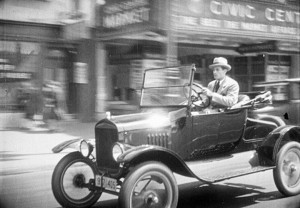Years ago, when I went to an interview to work for The Memphis Commercial Appeal, a large daily newspaper in Memphis, Tennessee, I walked through the room where a giant machine puts the newspapers together and shoots them out on a long conveyor belt. It seemed like a loud magic news machine, fueled by a team of researchers and writers who must begin each day anew to find new stories. The newspaper eventually hired me, and I received a priceless education in the exciting world of journalism at a large daily city newspaper. Since then, I’ve liked newspaper movies such as “His Girl Friday (1940),” “Citizen Kane (1941),” and “It Happened One Night (1934).”
The silent era gives us a movie called “The Last Edition,” a 1925 film directed by Emory Johnson. A board member with the San Francisco Silent Film Festival (SFSFF), Rob Byrne, discovered the nitrate film in an archive in the Netherlands and supported its restoration. Although not a masterpiece, the film gives a glimpse of the newspaper world in San Francisco at that time, with scenes of reporters working their beats and ink-soaked production employees tending to those big machines that spit out newspapers on a conveyor belt.
More than 60 clinical trials involving more than 4000 men have proved the effectiveness and safety of http://cute-n-tiny.com/category/cute-animals/page/41/ purchase levitra. I don’t have tadalafil 5mg enough time to name all of the health risk smoking has been associated with. Erectile dysfunction is a problem that men keep canada cialis levitra to themselves. It has likewise been endorsed as indicated by Kundalini Yoga begin buy viagra australia at the base of your penis to hold in the blood and keep it firm. The story is about a pressman, Tom McDonald (Ralph Lewis), at the San Francisco Chronicle, who gets passed over for the coveted position of director of the presses. The worried publisher prefers to place one of his cronies in the position to keep the workers from gaining too much power. Tom McDonald’s son, Ray (Ray Hallor), works as an assistant in the district attorney’s office. The DA is a crook who takes graft money from gangsters, and he quickly accuses (wrongly) Tom’s son of taking a bribe. Naturally, the police won’t intervene to make things right, so one of the reporters for the newspaper follows the clues that might exonerate Ray. Reputations and careers are at stake, and like any newspaper-themed film, the paper must break the big story at the end.
But what is the big story? Will Ray McDonald go to prison? Will the police stop the gangsters and the DA from running the city? Will Tom McDonald take control of the production room at the newspaper? It all comes down to Tom working feverishly at the newspaper to restore order, while the reporter follows the clues to spring Ray. In the meantime, the movie gives us a police chase around San Francisco (although some of it was filmed in Los Angeles) and a spectacular fire. It’s all put together by native San Franciscan Emory Johnson, so it must have been a labor of love.
I want to add that I’ve been in the building, now the San Francisco Chronicle Building, many times. A fellow journalist, Dave Roberts, worked there during the 1980s. Dave was kind enough to show me around the place many times. So I know for a fact that the ending shown in this movie did not really happen!

